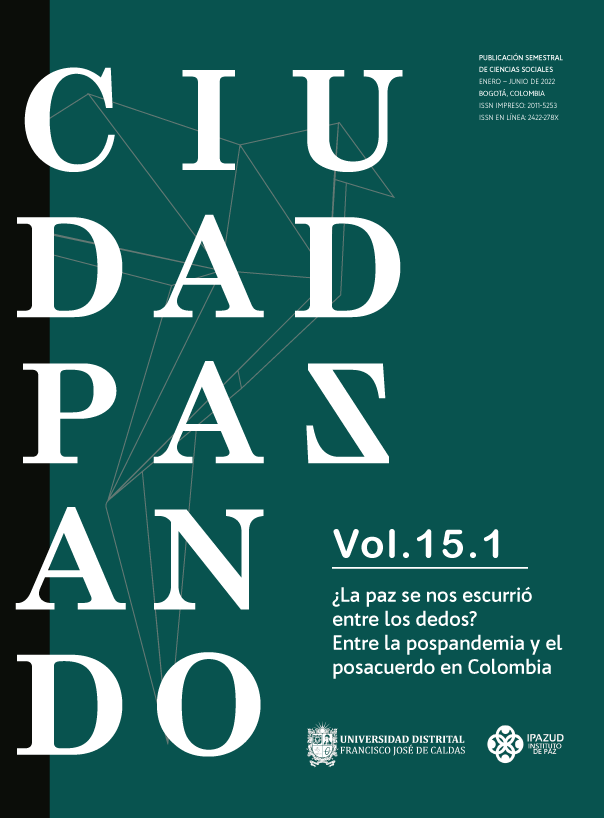DOI:
https://doi.org/10.14483/2422278X.18016Published:
2022-04-18Issue:
Vol. 15 No. 1 (2022): ¿La paz se nos escurrió entre los dedos? Entre la pospandemia y el posacuerdo en ColombiaSection:
Dossier centralCartografías e Imágenes de la Memoria: Una Ruta Hacia el Análisis de los Procesos de Recuerdo y Olvido de los Habitantes de la Zona Rural de Ciudad Bolívar
Cartographies and memory images: a route towards the analysis of the remembrance and forgetfulness processes in the rural area habitants of Ciudad Bolívar
Keywords:
Memory, Image, Cartography (en).Keywords:
Memoria, Cartografía, Imagen (es).Downloads
Abstract (es)
Los diferentes matices, transgresiones y proyecciones que establece la memoria en los espacios, usos, objetos y prácticas cotidianas observadas en los habitantes de la zona rural de Ciudad Bolívar, son analizados por medio de la imagen que, al ser entendida como un instrumento mental y gráfico que provoca procesos de recuerdo y olvido, es capaz de producir una serie de cartografías y narrativas que evidencian las formas particulares utilizadas por esta comunidad para hacer memoria. El tránsito a través del cual una imagen se convierte en memoria, y ésta a su vez encuentra en la narración u otros dispositivos la posibilidad de ser expresada y compartida, hace efectiva la posibilidad de construir una propuesta investigativa que instala los escenarios y herramientas necesarias para reflexionar sobre la memoria y la manera en que ésta se tramita por parte de la comunidad intervenida. Basado en lo anterior, el objetivo de la presente investigación es analizar las imágenes que configuran los procesos del recuerdo y el olvido de los habitantes de la vereda de Pasquilla, con el propósito de diseñar y desarrollar una cartografía que dé cuenta de las formas de la memoria que se manifiestan a través de la narración.
Abstract (en)
This article analyzes, through image, the different nuances, transgressions and projections that establish memory in the spaces, uses, objects and daily practices observed in the rural inhabitants of Ciudad Bolívar. The image is understood here as a mental and graphic instrument that provokes processes of remembering and forgetting, and a tool capable of producing a series of cartographies and narratives that show the particular forms used by this community to make memory. The way in which an image becomes a memory and a narration with the possibility of being expressed and shared, makes effective the building of an investigative proposal that installs the necessary scenarios and tools to reflect on the memory and the way community intervened it. The objective of this research is to analyze the images that make up the processes of memory and forgetfulness in the inhabitants of the Pasquilla village, with the purpose of designing and developing a cartography that describes the forms of memory that are manifested through the narrative.
References
Alcaldía Mayor de Bogotá. (2014). Almanaque agroecológico Pasquilla. Instituto distrital de patrimonio cultural.
Bal, M. (2016). Teoría de la narrativa. (una introducción a la narratología). Catedra.
Barthes, R. (1983). Ensayo Críticos. Seix Barral Ediciones.
Bourdieu, P. (2007). El sentido práctico. Siglo XXI Editores.
Bourdieu, P. (2011). La ilusión biográfica. Acta Sociológica, 56, 121-128. https://doi.org/10.22201/fcpys.24484938e.2011.56.29460
Deleuze, G. y Guattari, F. (2002). Mil mesetas. Capitalismo y esquizofrenia. Pre-textos.
García, G. (2007). Cien años de soledad. Santillana Ediciones.
Gómez, N. (2014). Partir de lo que somos Ciudad Bolívar, Tierra, Agua y Luchas. Alcaldía mayor de Bogotá.
Le Goff, J. (1991). El orden de la memoria. El tiempo como imaginario. Paidós.
Rey, P. (2010). Vivienda, sectores populares y transformaciones urbanas en Bogotá. 1890-1910. Territorios 23. Pp. 13-32
Riaño, P. (2006). Jóvenes, memoria y violencia en Medellín. Una antropología del recuerdo y el olvido. Editorial Universidad de Antioquia.
Robbe-Grillet, A. (1986). El espejo que vuelve. Editorial Anagrama.
Rulfo, J. (2000). Pedro Páramo. Ediciones Cátedra.
Sowell, D. (2006). Artesanos y política en Bogotá. Ediciones Pensamiento Crítico.
Zambrano, F. (2004) Historia de la localidad de Tunjuelito. El poblamiento del valle medio del río Tunjuelo. Editora Guadalupe.
How to Cite
APA
ACM
ACS
ABNT
Chicago
Harvard
IEEE
MLA
Turabian
Vancouver
Download Citation
License
Copyright (c) 2021 Ciudad Paz-Ando

This work is licensed under a Creative Commons Attribution-NonCommercial-ShareAlike 4.0 International License.
The Ciudad Paz-ando Journal (RCP) is an open access publication, without economic charges for authors or readers, whose biannual publications are made under the terms of the Creative Commons Attribution - Non-commercial - Share the same License (CC-BY-NC -SA 2.5 CO), with which others may distribute, remix, retouch, and create from the work in a non-commercial way, as long as they give credit and license their new creations under the same conditions.
The copyright holder is Ciudad Paz-ando journal, retaining all rights without restrictions, respecting the terms of the license regarding the consultation, download and distribution of the material.
When the work or any of its elements are in the public domain according to the applicable current law, this situation will not be affected by the license.
Likewise, we encourage authors to deposit their contributions in other institutional and thematic repositories, with the certainty that culture and knowledge is a good for all and for all.

